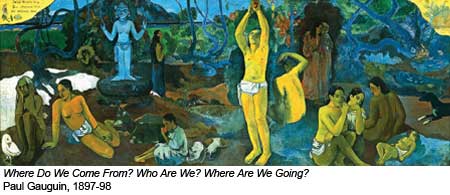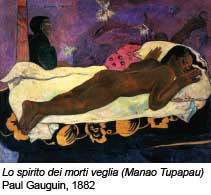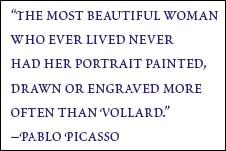SEARCHFULL EDITION April 2007CHECK OUT F ZINEFZINE: a place for high school students and teachers to read, interact, and contrbute. LAUNCH |
Review

by Steven L. Bridges above from Pierre Bonnard. Ambroise Vollard with His Cat, c. 1924.
 However, there is a much less glamorous side to these relationships. Looking beyond the extravagant dinner parties—Vollard was renowned for his curried chicken and his knack for lively and boisterous discussions—there are accusations of treachery, exploitation, and mishandling of artists’ accounts. Henri Matisse and Paul Gauguin were among those who had less than favorable interactions with Vollard. It is documented that Matisse once referred to Vollard as a thief (in French, voleur). While Vollard was the definitive beneficiary of the relationship between the two, the prominence offered Gauguin as a result of their business interaction cannot be overlooked.  Upon returning to the Art Institute to consider again this exhibition and in hopes of confirming my sneaking suspicion of some greater, underlying significance, I couldn’t help but feel empathetic for the countless travelers and seekers of artistic wisdom as they glided from one image to the next, becoming ghostly apparitions of the personae they had checked at the door. How much had they spent to be here, to listen to some strange voice echoing interpretations in their ears, trying to engage themselves, to understand? Upon returning to the Art Institute to consider again this exhibition and in hopes of confirming my sneaking suspicion of some greater, underlying significance, I couldn’t help but feel empathetic for the countless travelers and seekers of artistic wisdom as they glided from one image to the next, becoming ghostly apparitions of the personae they had checked at the door. How much had they spent to be here, to listen to some strange voice echoing interpretations in their ears, trying to engage themselves, to understand? The irony was not lost; instead, it was rolled up in tight wads or crammed in bulky wallets. In visiting an exhibition that is, for the most part, about the art market, visitors perpetuate the very same system. I was able to conclude, at last, that the exhibition is not about Cézanne, nor Picasso, not even Vollard, as the title suggests. Cézanne to Picasso is an embodiment of the intersections between capitalism and art: processes, manipulations, and, above all else, a testament to the power of this market. As such, the show is a mysteriously dark and cavernous structure with a most beautiful and entrancing façade. Cézanne to Picasso: Ambroise Vollard, Patron of the Avant-Garde is on display now through May 12, 2007 at the Art Institute of Chicago (111 S. Michigan Avenue).
images courtesy of the Art Institute of Chicago Click here to Tell your Friends about this page
|
||||
| A PLETHORA OF LINKS FOR YOU ! |
 Cézanne to Picasso: Ambroise Vollard, Patron of the Avant-Garde
Cézanne to Picasso: Ambroise Vollard, Patron of the Avant-Garde